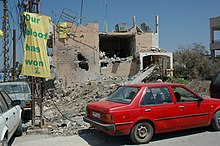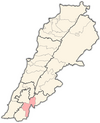Tayibe
طيبة الطيبة (مرجعيون) | |
|---|---|
Village | |
 Posters on Tayibe village walls after the
2006 Lebanon War | |
| Coordinates: 33°16′35″N 35°31′14″E / 33.27639°N 35.52056°E | |
| Grid position | 198/297 PAL |
| Country | |
| Governorate | Nabatieh Governorate |
| District | Marjeyoun District |
| Elevation | 660 m (2,170 ft) |
| Time zone | UTC+2 ( EET) |
| • Summer ( DST) | UTC+3 ( EEST) |
| Dialing code | +961 |
Et Taibeh | |
 | |
| Alternative name | Et Tayibe |
|---|---|
| Location | 2 kilometres (1.2 mi) south of the Litani River |
| History | |
| Periods | Heavy Neolithic |
| Cultures | Qaraoun culture |
| Site notes | |
| Archaeologists | Louis Dubertret and Jacques Cauvin |
| Public access | Unknown |
Tayibe, Et Tayibe or Et Taibeh is a village in the Marjeyoun District in south Lebanon.
Name
According to E. H. Palmer, the name Tayibe means "The good, sweet, or wholesome" (about water). [1]
Archaeological site
By the village is a Heavy Neolithic archaeological site of the Qaraoun culture. [2] [3]
The site was discovered by Louis Dubertret and materials studied by Jacques Cauvin. Heavy Neolithic materials recovered resembled those from Qaraoun. [3]
History
In 1875, Victor Guérin found here a village with 800 Metualis. [4] He further noted: "Its principal mosque, now in ruins, is built of superb blocks, apparently ancient. It contains in the interior several monolithic columns." [5]
In 1881, the PEF's Survey of Western Palestine (SWP) noted here: "There are several sarcophagi and cisterns in the village ; some caves near." [6] They further described it as: "A large well-built village, built of stone, containing about 600 Metawileh and 400 [Sunni] Moslems. The Caimacam has a good house here. There are some figs and olives round the village and arable land; water is supplied from a spring and two birkets." [7]
Modern era
On August 5, during the 2006 Lebanon War, Israeli war-planes killed 3 civilians, aged 2 to 48 years of age. The IDF offered no explanations to the strike. [8]
See also
References
- ^ Palmer, 1881, p. 33
- ^ Moore, A.M.T. (1978). The Neolithic of the Levant. Oxford University, Unpublished Ph.D. Thesis. pp. 444–446.
- ^ a b L. Copeland; P. Wescombe (1966). Inventory of Stone-Age Sites in Lebanon: North, South and East-Central Lebanon, p. 53. Impr. Catholique. Retrieved 29 August 2011.
- ^ Guérin, 1880, pp. 268-269
- ^ Guérin, 1880, pp. 268-269; as given in Conder and Kitchener, 1881, SWP I, p. 139
- ^ Conder and Kitchener, 1881, SWP I, p. 139
- ^ Conder and Kitchener, 1881, SWP I, p. 90
- ^ HRW, 2007, p. 131
Bibliography
- Conder, C.R.; Kitchener, H.H. (1881). The Survey of Western Palestine: Memoirs of the Topography, Orography, Hydrography, and Archaeology. Vol. 1. London: Committee of the Palestine Exploration Fund.
- Guérin, V. (1880). Description Géographique Historique et Archéologique de la Palestine (in French). Vol. 3: Galilee, pt. 2. Paris: L'Imprimerie Nationale.
- HRW (2007). Why They Died: Civilian Casualties in Lebanon During the 2006 War. Human Rights Watch.
- Palmer, E.H. (1881). The Survey of Western Palestine: Arabic and English Name Lists Collected During the Survey by Lieutenants Conder and Kitchener, R. E. Transliterated and Explained by E.H. Palmer. Committee of the Palestine Exploration Fund.
External links
- Taybeh (Marjaayoun), Localiban
- Survey of Western Palestine, Map 2: IAA, Wikimedia commons

